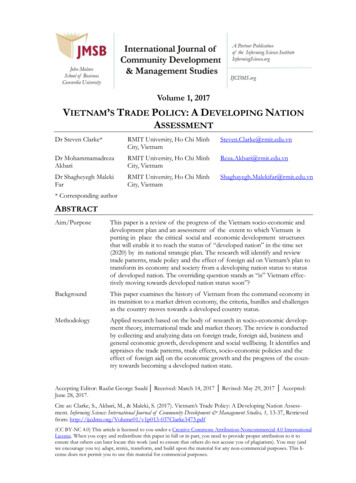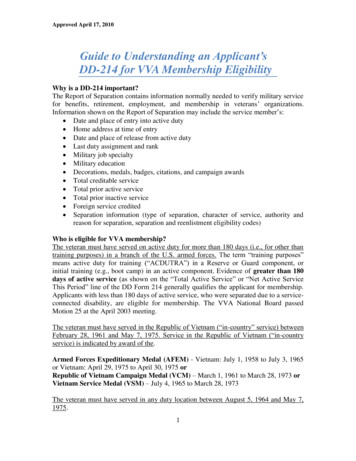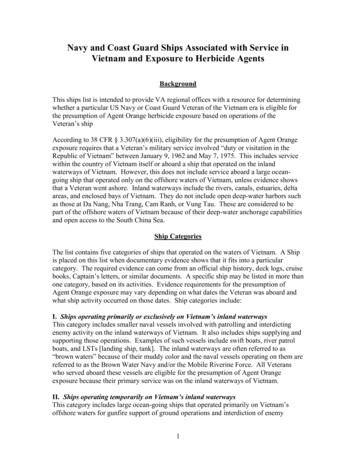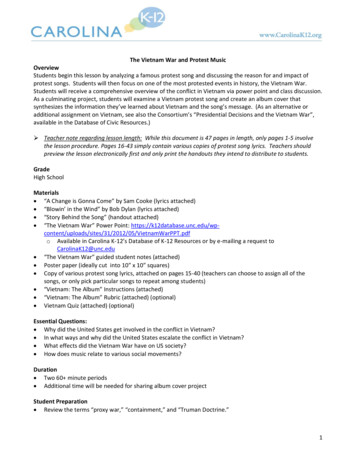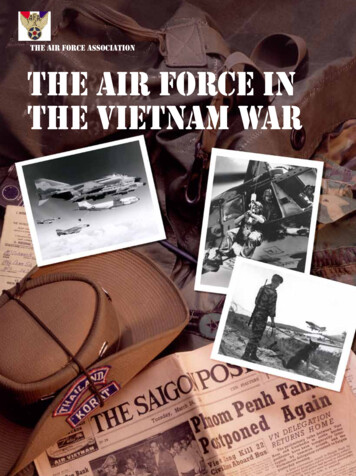
Transcription
Did the Vietnam Draft Increase Human Capital Dispersion?Draft-Avoidance Behavior by Race and Class Ilyana KuziemkoPrinceton and NBERJanuary 2010AbstractPast research has documented draft-induced college enrollment during the Vietnamera, but the draft also incentivized men with no hope of attending college to disinventin traditional forms of human capital (e.g., engage in criminal activity) so as to appearunfit for service. Using individual-level panel data, I find that receiving a “bad” draftlottery number increases college attendance the following year among whites, but itdecreases college attendance while increasing self-reported delinquent activity amongblack and low-income men. Moreover, men with bad numbers are over-represented instate administrative criminal justice records from the early 1970s. These results suggestthat the Vietnam draft may have been an important factor behind the rapid rise incrime rates among young men beginning in the mid-1960s. I wish to thank seminar participants at Princeton, Rutgers, Bocconi, UCL, LSE, the NBER SummerInstitute, Yale Law School, and NYU for helpful feedback, and Josh Angrist, Marvin Danielson, MarkDuggan, Ed Glaeser, Seema Jayachandran, Larry Katz, Alan Krueger, Steve Levitt, Michael Norton andShanna Rose for extensive comments and conversations. Kristin Plys ably assisted this research. DebbieNexon provided administrative support and also interesting personal anecdotes related to the hypothesesexplored in the paper. All errors are my own. Contact information: Princeton University, 361 Wallace Hall,Princeton, NJ 08544; kuziemko@princeton.edu.
“It’s better in jail, watching television, fed / Than in Vietnam somewhere. Dead.”- Muhammad Ali, 19671IntroductionU.S. military drafts have rarely drawn evenly from the socio-economic status distribution.Although Congress banned the use of “commutation fees” (whereby men could pay 300, orabout 5,200 in 2009 dollars, to avoid serving in the Union Army) in 1864, throughout the20th century men from privileged backgrounds could often avoid combat duty through favorable assignments or avoid military service altogether through educational or occupationaldeferments. At the other end of the spectrum, less privileged men were often disqualifiedfrom service on the grounds of mental, moral or physical deficiencies.1I develop a model that illustrates how imposing a military draft that excludes the tailsof the human capital distribution can increase human capital dispersion. Specifically, thedraft encourages men already in the right tail of the human capital distribution to “dodgeup,” or increase human capital investments so as to attain a student deferment. In contrast,it encourages men in the left tail to “dodge down,” or disinvest in human capital so as toappear unfit for service.I then test the model in the context of the Vietnam draft. The key empirical challengeis separating the effect of draft-avoidance behavior from the effect of actual military service,as any increase in the probability of the latter (e.g., a “bad” draft lottery number) directlyincreases incentives to engage in the former.2 To address this identification problem, I exploitthe draft lottery (following the influential work of Angrist 1990) but focus on outcomes inthe months immediately following the lottery, before men would have started any tour ofduty. I also make special use of the February 1972 lottery—originally meant to determine1973 call-ups, but rendered moot in January 1973 when an all-volunteer force replaced thedraft—which severs the connection between draft avoidance incentives and actual militaryservice.31Levine (1981) discusses commutation fees during the Civil War. Angrist and Krueger (1994) argue thatmilitary service during World War II demonstrated more positive than negative selection with respect tohuman capital and show that blacks were under-represented among World War II veterans. Similarly, ThePresident’s Task Force on Manpower Conservation (1964) shows how military standards disqualified manypoor and minority men during the first twenty years of the Cold War. See Section 2.1 for a much moredetailed discussion of this type of selection during the Vietnam Draft.2For convenience, I will often refer to “bad” or “good” draft lottery numbers by which I mean numbersassociated with, respectively, a high or low probability of being drafted. Note that a number with a highdraft probability is strictly “bad” in the classical economic sense of restricting choice, whereas a numberwith a low draft probability did not preclude a man from volunteering.3Angrist (1991) shows that 1972 lottery numbers are still predictive of military service the followingyear. Some men with bad lottery numbers preferred to volunteer instead of waiting to be drafted because1
I find support for the model from a variety of sources. Drawing on a little-used panelsurvey of men who were high school sophomores in 1966, I find that white and high-SESmen who receive bad 1969 lottery numbers attend college at higher rates in 1970, but blackand low-SES men with bad numbers if anything have lower rates of 1970 college attendance.The white “dodging-up” result is generally in line with past work such as Card and Lemieux(2001) and Malamud and Wozniak (2009), who find a positive correlation between draft riskand college enrollment, though they use variation in draft risk at the year and state-yearlevel, respectively, and generally do not focus on differences by race or class.While the differential “dodging-up” results add nuance to past findings on the Vietnamdraft, the empirical work mainly focuses on investigating the “dodging-down” hypothesis. Ifirst test the “dodging-down” hypothesis using the dataset described above, and find thatblack and low-SES men with bad 1969 lottery numbers report higher levels of delinquencyduring the Spring of 1970 relative to their counterparts with good numbers.I then turn to administrative criminal justice records from two states that released datafrom the Vietnam era that include individuals’ exact birthdays. Men with bad February 1972lottery numbers are significantly over-represented in both arrest data from New York stateand prison data from Georgia during the twelve months following the lottery. Back-of-theenvelope calculations suggest that dodging down could explain up to 30 percent of the sharprise in crime rates among young men between 1965 and 1970.My results may help to broaden our understanding of the impact of the Vietnam Waron the roughly 27 million American men who came of age during it: not only the 2.2 millionmen sent to Vietnam and the 9 million others who performed non-combat duty elsewhere(often on U.S. soil), but the large majority who did not serve in the war at all.4 Althougha relatively small share of men served in Vietnam, survey data suggest that many men whodid not serve took explicit steps to avoid doing so.5 Thus, avoidance behavior—whetherdodging up or down—may have significantly influenced social and economic outcomes forthis generation. If, as my analysis suggests, the type of draft-avoidance behavior is a functionvolunteering could sometimes lead to better assignment (though also required a three-year tour of dutyinstead of draftees’ two-year tours). I discuss this paper in more detail in Section 2.2 and I argue in Section6.1 that such draft-induced volunteering would bias estimates against finding my results.4Statistics taken from Martin (1986).5Baskir and Strauss (1978) report that over sixty percent of men who did not serve in combat admittedto taking explicit steps to decrease their likelihood of doing so. They base the claim on a 1975 survey of1,586 men from Washington, D.C., South Bend, Indiana, and Ann Arbor, Michigan, known as the NotreDame Survey of the Vietnam Generation. This estimate would appear to be a lower bound on the numberof surveyed men who made decisions in part based on the draft. Some may have consciously changed theirbehavior in response to the draft but chose not to disclose doing so to the surveyors, while others may havesubconsciously reacted to their draft number (e.g., taken risks because their bad number led them to believethey faced a shorter time horizon).2
of race and class, then the draft would affect not only the social and economic outcomes ofthe Vietnam generation relative to other generations but the dispersion of such outcomeswithin the Vietnam generation itself.The dodging-down effects I find might also contribute to a long-standing debate amongsocial scientists. Social and economic indicators of under-privileged young men, and especially African-American young men, suddenly and unexpectedly deteriorated around 1965,after years of slow but steady improvement following World War II. Critics such as CharlesMurray claim that Great Society welfare programs created large and immediate incentivesagainst work, education and marriage, whereas others such as William Julius Wilson cite thedisappearance of low-skill jobs and negative peer effects as middle-class blacks left the innercity for newly integrated suburbs.6 My results suggest that for many under-privileged youngmen, the Vietnam Draft dramatically decreased the perceived return on traditional forms ofhuman capital, creating fertile ground for the criminal activity, marginal labor-force attachment and elevated high school drop-out rates that began to characterize urban communitiesduring this period.The remainder of the paper proceeds as follows. Section 2 provides a short history ofthe Vietnam draft and its impact on black and low-SES men. Section 3 models how draftavoidance behavior varies with initial human capital levels. Section 4 translates the resultsof the model into empirical predictions testable using standard variables from micro-datasets. Section 5 describes the 1966-1970 longitudinal survey of male high school students andpresents evidence that bad 1969 lottery numbers predict higher 1970 college attendance ratesfor white and high- and middle-SES men, but higher 1970 rates of self-reported delinquencyamong blacks and, to a lesser extent, low-SES men. Section 6 presents evidence that menwith bad numbers are over-represented in criminal justice data from both New York andGeorgia. Section 7 discusses directions for future research and offers concluding remarks.2The Vietnam Draft and Avoidance Behavior2.1Background on the draftThe only time the United States relied on a sustained military draft during the 20th centurywas between 1940 and 1973. President Roosevelt instituted the draft just over a year priorto Pearl Harbor and policymakers maintained the draft after World War II in part to directmanpower to its most productive use during the Cold War, a process known as “channeling.” General Lewis Hershey, director of the Selective Service from 1940 to 1970, describedchanneling as “developing more effective human beings in the national interest” by deciding6See Murray (1984) and Wilson (1990).3
“whether a young man is more valuable as a father or a student or a scientist or a doctorthan as a soldier” (Baskir and Strauss, 1978, p. 22). Local boards were charged with carrying out this goal when classifying all 18- to 25-year-old men in their jurisdiction, the mostcommon classifications being I-A (ready for duty), II-S (student deferment), III-A (hardshipdeferment), and IV-F (unfit for service). Though men were technically draft-eligible untiltheir 26th birthday, the average age of induction was generally between 19 and 20, and veryfew men were inducted after their 23rd birthday.7For much of this period, the draft was not a highly controversial institution: quotas werevery low, deferments and exemptions were granted liberally, and being drafted rarely ledto combat duty. Indeed, low quotas in the decade following the end of the Korean War in1953 made it possible to adopt such high physical, mental and moral standards that thefamous study “One-third of a Nation” revealed that one-third of 18-year-old men in 1964were deemed unfit for service.8As manpower needs increased during the Vietnam War, quotas shot up and draft boardsbecame stingier with deferments. Moreover, service suddenly entailed serious risk of injuryor death, drawing national attention to the conscription process. In 1969, Congress requireddraft boards to fill 1970 quotas based on an annual, televised lottery in which birthdates wererandomly drawn from an urn. Military call-ups began with the lowest numbers and continuedupward until the year’s manpower needs were met. By the end of 1970, for example, call-upshad reached number 195 out of a total of 366.9 The 1970 draft began the practice of limitinginduction risk to the birth cohort turning 19 in the year of the lottery, ending the unpopularpolicy of men being technically eligible to be drafted until their 26th birthday. Importantly,while the lottery determined the order of call-ups among men classified as I-A, local boardsretained discretion over classifications (e.g., I-A versus II-S).The need for a draft in the first place and policy-makers’ later concern that it appearfair suggests limited enthusiasm for the war among draft-age men, an underlying premiseof the model presented in Section 3. However, some scholars have argued that many black7See U.S. Selective Service System, (various years). In June of 1967, the last time detail beyond the meanof the age distribution was reported, all but 4.6 percent of men awaiting pre-induction examinations werebetween 18 and 23 years old.8See Davis and Dolbeare (1968, p. 14) for a discussion of the inverse relationship between manpowerneeds and military standards.9In 1971, those with 1970 numbers below 125 were called up; in 1972, those with 1971 numbers below95 were called up; in 1973 no call-ups were made as the all-volunteer force replaced the draft, rendering the1972 numbers essentially moot. The December 1969 draft applied not only to the 1950 birth cohort but toanyone born between 1944 and 1950 without military service—thus, 366 lottery numbers were needed tocover the cohorts born in the leap years 1944 and 1948. These cut-offs were obviously determined ex-post,based on the needs of the military in the year following a given lottery. As such, men did not know ex-antewhich lottery numbers would turn out to be “safe.” Men subject to the 1969 lottery likely faced the mostuncertainty, as no previous cut-offs existed and the direction of the war at that point remained unclear.4
and low-SES men wanted to serve in Vietnam, which would cut against the dodging-downthesis. In the next two subsections I review and critique some of this work and then provideevidence that many blacks and low-SES men opposed service in the war.2.2Potential benefits of military service for blacks and low-SES menSome previous research suggests that black and low-SES men may not have objected tomilitary service in Vietnam. First, Angrist (1990) finds that receiving a bad lottery numberwas not associated with diminished labor-market outcomes for blacks and may have in factled to later educational gains through the GI bill (Angrist, Chen, and McCrary, 2008).Second, popular press accounts of the resistance movement often stressed its elite, welleducated leadership and its occasional conflicts with working-class supporters of the War(Foley, 2007).In the most direct work on this question, Angrist (1991) argues that blacks more willinglyjoined the military than did whites during Vietnam. Using a compelling empirical strategy,he focuses on draft-induced enlistment—“voluntary” enlistment of men who otherwise wouldhave been drafted. Enlisted men (who entered voluntarily) often had more control over theirassignments than did inducted men (who entered via the draft) and thus many men withbad numbers chose to enlist instead of waiting to be inducted (though enlisted men servedthree years instead of the two required for inducted men). He shows that enlistment rates ofboth whites and blacks fall with their 1970 lottery number. However, the gradient for whitesis steeper and whites’ enlistment appears more sensitive to whether their number is aboveor below the previous year’s cut-off, consistent with whites volunteering only if they knewthey would be drafted and blacks “truly” volunteering.2.3Opposition to the war among blacks and low-SES menCertainly some blacks (and, of course, some whites) eagerly volunteered. However, it ispossible that the trends identified by Angrist (1991) reflect differences between blacks’ andwhites’ awareness of, or confidence in their ability to exploit, any enlistment advantage.Moreover, as I present in this subsection, much evidence suggests that many blacks andlow-SES men may have felt serious opposition to military service in Vietnam.2.3.1Black casualty ratesIn a March 1966 publication that sparked anger among African-Americans, the Pentagonreported that blacks made up over 18 percent of deaths in Vietnam, even though they comprised only 13 percent of combat forces (Raymond 1966 and Raymont 1966). Only because5
of a concerted effort later in the War to address the appearance of discrimination did thewhite casualty rate start to approach that of blacks.10 Figure 1 shows the black share ofcombat deaths each year of the conflict, using data from the National Archives’ CombatArea Casualty Current File (CACCF). Black over-representation appears to peak in 1966,consistent with explicit efforts to reduce disparities triggered by the negative reaction to thereport.While the Pentagon report showed that blacks faced higher death rates conditional oncombat duty, the racial disparity conditional on military service in general was far worse,as non-combat military assignments were not usually accessible to blacks. For example,throughout the conflict blacks never made up more than 1.3 percent of the Army and AirNational Guard (Long, 1993). Figure 1 shows that it was not until 1973 that the black shareof deaths fell below that of the black share of military personnel. I calculate that in 1966,blacks faced a death rate conditional on military service that was two-and-a-half times thatof whites.11The CACCF data do not include measures of class, but to the extent that black casualtyrates were high not because of outright racism but because blacks’ education and backgroundrelegated them to dangerous assignments, the death rates of working-class men would be highas well.2.3.2Attitudes toward the war among blacks and the working classEvidence from a number of sources suggests the war quickly lost the support of blacks andthe working class. I already noted the anger over the Pentagon report, and “Black Power”groups made resistance to the draft a centerpiece of the movement.12 Less anecdotal evidencecomes from a February 1966 National Opinion Research Center (NORC) survey on attitudestoward the War.13 Table 1 presents results from simple regressions that relate attitudestoward different policy options to demographic and socio-economic characteristics.Blacks are 20 percentage points (or 44 percent, given a 45 percent baseline level forwhites) less likely to agree that “we should continue the fighting even if several hundred U.S.10See discussions in Baskir and Strauss (1978) and Graham (2003).CACCF data indicate that blacks make up 16.33 percent of 1966 deaths and whites 81.77; 1970 censusdata indicate that blacks (whites) account for 7.43 (91.66) percent of all 24-year-old Vietnam-era veterans,which I use as a proxy for having served in the military in 1966. Therefore, blacks faced a death rateconditional on military service that was (16.33/7.43)/(81.77/91.66) 2.46 times that of whites. Militarydata on race are only available for enlistees and not inductees during the 1960s, so the Census appears tooffer the best estimates.12For example, the Black Panther Party called for the abolition of black military service in its originalten-point manifesto (Alkebulan, 2007).13The last day NORC surveyed any subjects was March 7, 1966, and the Pentagon released its report onblack combat deaths on March 9, so subjects were not privy to the results of the report.116
troops are lost each week,” 25 percentage points (68 percent) more likely to favor “graduallywithdrawing to let the Vietnamese work out something on their own” and 16 percentagepoints (64 percent) more likely to favor “withdrawing even if the communists take over SouthVietnam.” In contrast, higher education and social class predict more hawkish attitudes.14Indeed, as early as 1966 (two years before the significant U.S. casualties incurred during theTet Offensive and four years before the shootings of anti-war protesters at Kent State) lessthan 38 percent of whites without a high school degree approved continuing the war despitehigh casualties and over 43 percent favored a gradual withdrawal, compared to 51 and 37percent, respectively, for those with at least a high school degree. In short, many black andworking class men and their families did not support the war and thus were unlikely to beenthusiastic about military service.2.4Avoidance behaviorAs mentioned at the end of Section 2.1, even after the introduction of the lottery system, localdraft boards retained the power to determine classifications. Thus, a young man with a badlottery number could still avoid service if the board granted him, say, a student deferment.15Similarly, a man with a bad lottery number could still be rejected due to a mental, physicalor moral defect.The criteria for gaining II-S status (“dodging up” and gaining student deferment) weregenerally very clear. Essentially, anyone enrolled as a full-time undergraduate student at acollege or university was granted II-S status as GPA requirements were abolished in 1967.16Importantly, men attending college part-time and men attending junior college or vocationalschool could not qualify, which prevented many black and poor students from obtainingdeferments.The criteria for gaining IV-F (“dodging down” and being declared unfit for service) wereunclear both de facto and de jure. Physical fitness was the subjective call of a doctor. Andwhile mental criteria were objective, they fell in 1966 as manpower needs grew.1714I only display multivariate regression results because they provide a more stringent test of the relationshipbetween race, SES and opinion of the war; however, the same relationships are readily apparent in simplecross-tabulations.15Nixon abolished student deferments at the end of 1971, but for the 1969 lottery, upon which my “dodgingup” analysis relies, men could still gain student deferments.16Leslie Rothenberg, the Coordinator for Selective Service Affairs for the University of California systemduring the Vietnam War, wrote in 1968: “The undergraduate college or university student.no longer needworry about the required class standings or the dreaded Selective Service College Qualification Tests, fora II-S student deferment is available to any student at a college, university or similar institution of highereducation, who is satisfactorily pursuing a full-time course of instruction toward a baccalaureate degree”(Rothenberg, 1968, p. 128).17Before 1966, only men who were above the 30th nationally-normed percentile of Armed-Forces Qualifying7
Perhaps the most relevant criteria, given the criminal outcome variables I later examine,are those related to “moral standards” and they too were not well-defined. First, these criteriavaried by military branch and, in some branches, were open to interpretation.18 Second, localdraft boards could decide to seek “waivers” for men who did not meet such standards. Menon probation, parole, in prison or awaiting trial were officially banned from the service, butoccasionally men on parole or probation received waivers (Rothenberg, 1968, p. 268).Anecdotal evidence suggests that some men did view a criminal record as a potentialticket out of military service. Baskir and Strauss (1978, pp. 58-9) describe anti-war protestersadvising men to commit crimes to avoid the draft. The Coordinator for Selective ServiceAffairs for the University of California system advised students not to pursue this strategy,suggesting at least some had tried (Rothenberg, 1968, p. 269).2.5DiscussionWhile only about a third of the 26 million men who were of draft age during the VietnamWar served in the military, the draft likely affected the decisions of many others. For thosewho did not wish to serve and who had the option of full-time attendance in a four-yearcollege, student deferments offered relatively reliable protection from military service. Butthose without the possibility of attending college had a more limited set of options. Somemay have engaged in criminal or other anti-social behavior either as an explicit attempt toavoid the draft, because combat duty shortened their time horizons and thus decreased thefuture cost of a criminal record, or simply because the prospect of forced military serviceangered or upset them. I examine these hypotheses more rigorously in the rest of the paper,first theoretically and then empirically.33.1Modeling Draft Avoidance BehaviorOverviewGiven the “channeling prcoess” described in the previous section, whereby men with highlevels of human capital were given student deferments and men with low levels were assignedTest (AFQT) score (in Groups I, II or III, in military parlance) were eligible to serve. In 1966, Secretary ofDefense Robert McNamara launched “Project 100,000,” which made Group IV men (between the 10th and30th percentile) eligible for military service. Since the adoption of the AFQT in 1950, Group V men (9thpercentile or lower) have been prohibited from service.18The Army disqualified men with “frequent difficulties with the law, criminal tendencies, antisocial behavior, alcoholism, drug addiction, sexual misconduct, questionable moral character;” the Navy, men convictedof a felony or any offense involving sex; the Air Force, men with “frequent difficulties with the law” and whohave committed certain offenses involving traffic accidents; the marines, men convicted of a felony or anycrime involving “moral turpitude” or a maximum sentence of more than a year.”8
to IV-F (unfit for duty) status, I model the draft as a tax on men with average human capitallevels. Similar to Mirrlees (1971) and other classic treatments of income taxation, individualsin my model react to this tax by deciding whether to modify their level of human capitalso as to avoid it.19 Those who already have relatively high levels of human capital find thatinvesting more and “dodging up” represents the cheapest way to avoid the tax; those withrelatively low levels find it optimal to disinvest and “dodge down.”3.23.2.1AssumptionsPreferences and constraintsIndividuals have identical, strictly convex preferences over current and future consumption.Each starts with a fixed stock of resources, to be divided between current consumption cpand human capital investment e. For example, individuals might divide their time betweenstudying and going out with friends, or their money between paying college tuition andbuying a new car.While human capital investment mechanically decreases present consumption, it increasesfuture consumption cf . Intuitively, human capital investment first gets transformed intohuman capital h, which is then transformed into income, or, equivalently, future consumptioncf , as individuals in the model cannot save. I assume that human capital investment e is notobservable, whereas the realized human capital level h is.Specifically, h h(w, e), where w is an exogenous parameter which encompasses individuals’ socio-economic background, innate ability or anything that decreases the level of erequired to reach any given h. I also assume that e and w are complements in the productionof h, and thus hw , he , and hwe are all strictly positive.Future consumption is a function of human capital: cf cf (h), with cfh 0 and cfhh 0.Intuitively, h can be thought of as a sufficient statistic for an individual’s apparent worth to aprospective employer. For example, low values of h would correlate with observable markerssuch as a criminal record and high values with a college education. cfh can also be thoughtof as the labor market return to human capital, as all income is consumed.20 The shape ofcf (h) thus determines individuals’ budget constraint in cf -h space.19In showing how individuals self-select to locate on different parts of the draft-induced budget constraint,I make use of the general framework derived from Mirrlees’ work on optimal income taxation (Mirrlees,1971). Whereas Mirrlees extended his analysis to optimal tax policy, I do not address the normative questionof the optimal draft, but merely the positive question of how individuals react to the incentives created bythe draft as it operated during the Vietnam War. Much of the work on individuals’ optimization without thedraft is a generalization of the Mirrlees model as described by Myles (1995).20I assume that cfhh is negative despite the fact that labor economists generally specify (pre-tax) incomeas a linear function of years of schooling. Given the progressive income tax during this period, I assume thatconsumption is a concave function of pre-tax income and thus a concave function of human capital h.9
Before adding more notation, two aspects of the model so far deserve further discussion.First, as suggested above, I take a very broad view of e (and thus current consumption). Itencompasses such factors as the psychic cost of effort, the pecuniary cost of tuition, or theopportunity cost of leisure. I denote investment as e in part to suggest “effort.” For example,studying for a high school exam would increase e and thus decrease current consumptioncp . But e also includes the up-front psychic cost of, say, abstaining from alcohol or druguse, criminal activity, or other activities that might, all else equal, const
Contact information: Princeton University, 361 Wallace Hall, Princeton, NJ 08544; kuziemko@princeton.edu. \It's better in jail, watching television, fed / Than in Vietnam somewhere. Dead." . survey of men who were high school sophomores in 1966, I nd that white and high-SES . of race and class, then the draft would a ect not only the .


